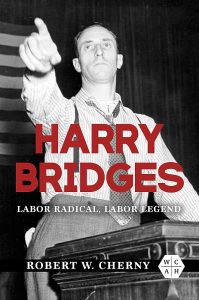Harry Bridges: Labor Radical, Labor Legend
 Harry Bridges: Labor Radical, Labor Legend by Robert W. Cherny (Urbana; University of Illinois Press, 2023)
Harry Bridges: Labor Radical, Labor Legend by Robert W. Cherny (Urbana; University of Illinois Press, 2023)
During the Great Depression several American labor leaders became household names. Harry Bridges was one of them. Along with John L. Lewis and others, he rose to prominence as a defender of working people. Aided by President Franklin Roosevelt’s New Deal, organized labor’s membership skyrocketed and union confrontation with management reached new levels. Never far from controversy, Bridges, an unabashed radical, stood out. In Harry Bridges: Labor Radical, Labor Legend, the culmination of thirty-five years of effort, Robert Cherny provides a majestic biography. It is the story of an Australian-born firebrand who led Pacific Coast waterfront workers as president of the International Longshore and Warehouse Union (ILWU) from 1937 until his retirement in 1977.
Cherny unhesitatingly details Bridges’ admiration for the Soviet Union, which often included following the Communist Party line and resulted in his near deportation from the United States and harassment during the McCarthy Era. In evaluating his achievements, Cherny primarily considers his “effectiveness as a union leader,” which he regards as positive. However, regarding his actual membership in the Communist Party, the biographer is inconclusive. He notes that “relevant evidence” from the Russian State Archive for Socio-Political History (RGASPI), made available in 1992, suggests that he [Bridges] was a Communist Party “’influential’ from 1934 onward.” This activity is persuasive, but not yet proof of party membership, which may have been the case, but “likely ended by 1938.”
1934 was a year for strikes, none more bitter than the one led by Harry Bridges. Seeking union recognition, higher pay and shorter hours, an estimated ten to twenty thousand longshoremen went on strike for eighty-three days. “On June 19, for the first time in forty-five years, no ship entered the Golden Gate,” and on July 4 “in the grip of a general strike, “San Francisco stood on the brink of class warfare.” The walkout, Cherny observes, “stands as the watershed in the history of Pacific Coast longshore unionism.”
Bridges, though, appeared to be tied to the Communist Party, even when it changed direction. Between 1935 and 1938 the CP adopted a “People’s Front (Popular Front) stance, which consisted of opposing fascism, supporting Franklin Roosevelt’s New Deal,” and calling communism “Twentieth-century Americanism.” Shifting in the international crosswinds, in 1939 the Communist Party tolerated the Molotov-Ribbentrop Agreement between Nazi Germany and the Soviet Union as an anti-war nonaggression pact. Bridges, who had led the West Coast longshoremen into the new Congress of Industrial Organizations the previous year, along with the CP, wound up supporting Republican Wendell Willkie against FDR in the 1940 presidential election. As Cherny describes, “fed up with Bridges and with all those [Communist] people,” Roosevelt, along with numerous others in business and politics, unsuccessfully attempted to have him deported. The deportation effort would continue to 1960.
As a maverick union president, Bridges remained in office through and beyond the Second World War. Against the Cold War tide, he opposed the Marshall Plan and endorsed Henry Wallace’s presidential campaign in 1948. His political leanings notwithstanding, he survived the McCarthy Era. What made him most effective as a union leader, Cherny emphasizes, was “his ability to relate to the rank and file, to represent them, to persuade them.” He retained their loyalty despite his concession to revolutionary changing technology in the shipping industry. With containerization unavoidable, he negotiated Modernization and Mechanization Agreements in 1960 and 1966.
Based on prodigious research in numerous archives, Cherny traces the controversial path of his incredible subject. During his final years Bridges received widespread appreciation as a “Living Legend in His Own Time.” In 1988, two years before his passing, he supported the ILWU’s affiliation with the American Federation of Labor and Congress of Industrial Organizations (AFL-CIO).
Reviewed by Robert D. Parmet, York College of The City University of New York
,
